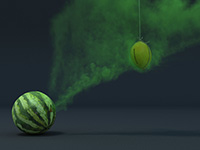


Pat Flynn
"Other Fatherland"
September 11-October 4, 2014
Reception September 11, 7-9pmIn conjunction with the Downtown Art Walk
Animation Stills "Other Fatherland" © 2014 Pat Flynn
Pat Flynn's work examines the language of the mass produced. His practice primarily covers photography, film and installation. His work draws on ideologies, processes, themes and sentiments found in Hollywood films, computer games, consumer goods and advertising.
Flynn creates narratives around our need to believe, the ways we fetishize belief and the ways in which we reflect on our mortality in light of this. His work fuses disparate rhetoric's moving between abstraction and figuration. In his predominantly digitally generated work, Flynn presents a fictionalised world full of cliché and pathos, a constructed sublime for passive beings.
"Pixels and Dust"
an essay on the work of Pat Flynnby Graham Parker
When Pat Flynn was a kid in the early 1980s, in the North West of England, he watched his brother type a short sequence of 'Draw' commands into a ZX Spectrum computer, to produce a series of circles onscreen. His brother was using a language called BASIC (Beginner's All-purpose Symbolic Instruction Code), which was devised in 1963 as an inefficient programming language in terms of speaking to the computer processor, but metaphorically explicit enough for non-specialists to describe and run simple operations on a microcomputer, in a syntax close to English. Having watched his brother, and entranced by the possibilities, Flynn used his own begrudgingly granted time at the keyboard to type his first command:
Draw me a castle
He describes the subsequent disappointment as one that has haunted his work since.
Today Flynn could build a virtual castle if he wanted. The onscreen possibilities of 3D programming grow exponentially with each new software iteration and Flynn is an adept visualiser and renderer of such imagery. But in his work, the adeptness is often married to visual depictions of limitation or failure in the face of the infinite, which of course carry an art-historical knowledge of the romantic sublime, but perhaps more personally echo a two-decade old error message received by a small boy in Manchester, trying to explain his imagination to a machine.
Flynn and I grew up at the same time in different provincial cities — Manchester and Belfast. Punk and Thatcherism, to name two phenomena, passed through the landscape at different
local speeds and frequencies, leaving transformed sensibilities and urban geographies we were both slightly too young to register as unnatural. Of the innovations we were self-consciously aware of, home computers began to be more affordable and a generation of kids began swapping cassette tapes of games alongside their compilation tapes of records and songs taped off the radio during Sunday night's chart rundown. At weekends the same kids might make their way to their local high street, possibly stopping in to the local Dixons or Curry's to sneak onto the computers on display and enter quick looped commands to make them repeat the kid's name, favourite band, or obscenity ad infinitum. Later, if we read Debord we might be told that it was impossible to think outside of the terms of the spectacle, but in those brief moments of minor delinquency on a particular screen in a particularly accented city, there was a hint of emancipatory local possibility. There was an illusory sense of freedom in the moment we saw ourselves reflected in what we took for public media space, within the second in which we hit the final return key.
Subsequently, the high streets these shops were located on were transformed by the market logic of the retail park and its flexible shells for high turnover commerce. In a recent project Flynn made a 3D computer model of just such a park, and captured a series of stills from it showing the park at peace under a brooding Martianred sky. With its Pizza Hut architecture and Macdonald's arches it is instantly legible, but there is no trace of human presence in the images — no rubbish, graffiti, teenage drinkers or 50-something security guards made redundant from manufacturing jobs. Just an eerie, pristine site, sitting under the indifferent heavens that hover over Lancashire and Kentucky alike.
Somewhere in those heavens is a small space probe carrying a Golden LP record featuring the sounds of earth and rudimentary information on humanity. The Voyager probe set off through the gas and dust of space in 1977, just as punk was transforming Mancunian popular culture and defining the cultural terrain Flynn's generation of artists would ultimately inherit. It's ironic to think of speed-fuelled Punk railing against the 'dinosaurs' of progrock, whilst the ultimate concept album sped amongst the dinosaur-slaying meteors. Punk left a legacy of cultural self-sufficiency in Manchester that was taken to an extreme in a city where the lingua franca was already chippy self-aggrandisement. Sometimes the city talked volubly to itself, in between buttonholing others to listen. And whilst somewhere along the line to globalisation and the 'free' exchange of information, many western cities had by necessity also turned back
in on themselves to assert specific, marketable identities within an increasingly homogenous global market, Manchester's mean mode of discourse seemed all too suited to giving up on dreams of outer space as both goal and metaphor. The Voyager probe exited the solar system in June 2006, after several Buzzcocks reunions, to the indifference of a generation of grown up kids who no longer drew rockets.
However, one of the kids had kept his eye on the imagined vanishing point of the receding probe — just as he'd stayed willfully out of step with the immediate cultural politics and follies of the city he lived in. A recent Diasec photographic diptych made by Flynn shows the Voyager probe in a mass of darkest space, alongside a night-time shot of a shark's eye emerging from water — the night sky reflected in it. It's brooding and ambitious and deeply melancholic. Flynn has a self-deprecating way of describing his preferred aesthetic as a kind of camp, but that may in part be a defence mechanism for justifying his work in a city where there are so many cultural forces mitigating against the use of the metaphysical poetics he relies on. It's his awareness of and navigation amongst these forces that I find intriguing. Flynn makes pixel perfect scenes that don't shy from addressing the awe of the sublime, whilst the artist himself is constantly negotiating and more or less successfully negating the real time quotidian experience of living in the sarcastic puritanism of Manchester, England.
In this dialectic spirit it's important to note that Flynn's electronic practice emerged out of a very physical sculptural practice, albeit one that was already mapping back populist electronic figuration into the physical world. An early experience I have of his work is of helping lift a lifesize sculpture of a car, coated in a laminated rendering of the pixels used to depict it in the background of a video game, out of a garage — trying not to scuff the edges or break our fingers as we tilted it onto the back of a van parked in Withington, Manchester. Games designers use sparse arrangements of pixels (and redundancies where possible) to create
visually credible background objects with the least amount of memory — aiming for a virtual weightlessness of sorts that keep the game flowing faster. Flynn would magnify and transfer these surfaces onto MDF frames to create lifesized sculptures of boulders, cars, etc. that had an equally decorative place in a world, but were subject to this world's physical laws and a contingent weight of melancholy.
The artist often refers with approval to an Edward Allington text in which Allington spoke of the 'futility' of surface in relation to sculpture and of coming in to his studio each morning to find his new work covered in a fine layer of dust. And when I think of the reasons for Flynn's increasing use of digital imagery as a primary medium in his work, following these earlier physical sculptures, I'm reminded of Bas Jan Ader's response to being asked why he made so much work about falling: "Because gravity defeats me."1
And yet defeat, failure and chance still haunt the smooth animations of Flynn's recent work — most explicitly in the lottery balls churning endlessly, suggesting a miniscule and endlessly postponed chance of victory. It's there, too, in the beautifully rendered and beautifully mistaken animation of the Ptolemaic universe as a child's mobile, with earth stood still at the center as the planets rotate around it — an animated conceit waiting to be undone by some digital Galileo's "And yet it moves."2
Perhaps most explicitly Flynn recently borrowed the Sinn Fein slogan, "Ourselves alone"3 for an exhibition title where, stripped of its defiant political context, it was transformed into a description of an existential aching that few of his peers dare admit to approaching.
In 1972 William Crowther, a computer programmer and amateur rock climber, found himself negotiating a divorce. Faced with limited access to his daughters and as a break from the pressures of writing assembly code for the routers of ARPAnet (think proto internet), Crowther wrote a text-based adventure game called 'Colossal Cave Adventure' (later just 'Adventure') for his daughters, loosely based on his climbing experience in the Kentucky Mammoth cave system — much of it carried out with his nowestranged wife, coincidentally called Pat, who had written the plotting program that enabled them to visually map their explorations. The game spread through the nascent internet, often discreetly installed and left on machines overnight to greet the next user with an unexplained magical world opening up from their terminal, albeit one described and navigable only in clipped, functional phrases that the user discovered by trial and error (as with BASIC its principal achievement was perhaps a linguistic interface that was intuitive to non-computer specialists: 'Look, Use, Listen, Take, Eat, Enter', etc).
'Adventure' defined a genre of gaming that has mutated into the multi-user online games and arguably many of the social-networking sites (MySpace etc) of today. In a celebrated and now iconic description from the start of the game, the scene is described thus:
You are in a 20-feet depression floored with bare dirt. Set into the dirt is a strong steel grate mounted in concrete. A dry streambed leads into the depression.
The scene matches the description of an actual entrance to the Bedquilt cave in the Mammoth system and some gamers claim to have been able to carry out rudimentary navigation of the caves from the description of the fictional caves described in 'Adventure'. Aside from that though, there's something of the necessarily brief descriptions permitted by the processing capabilities of computers at the time, that strikes a chord with me in thinking about Flynn's work both now and as a child asking the computer to draw him a castle. Just as Crowther's "20-feet depression floored with bare dirt" might be said to have its origins in both a patch of Kentucky hillside and personal, psychological terrain, so Flynn's animations, prints and sculptures wrestle with a very personal and local set of implications and histories. It's this tangible struggle, as much as any compositional element, that acts as a necessary punctum by which we can approach and experience these works as emotionally charged pixels set amongst our shared dust.
Graham Parker is an artist.
He lives in New York.
1 When Ader showed his films 'Falling I' and 'Falling
II' in Düsseldorf in 1971, they were accompanied
by an artist-drafted descriptive text reading
only: "The artist's body as gravity makes itself
its master." See Godfrey, Tony. Conceptual Art.
London: Phaidon Press Limited, 1998
2 "E pur si muove". Iconic, though probably
apocryphal, words spoken by Galileo after
recanting his defence of heliocentricism (a
theory undermining the Ptolemaic conception of
the universe) before a Papal inquisition. Stillman
Drake, Galileo at Work: His Scientific Biography,
(Dover Publications, Mineola, NY, 2003)
3 'Sinn Fein', Irish political party, whose name
literally translates from the Gaelic as 'We
Ourselves', more commonly, 'Ourselves alone',
Source, Sinn Fein.
.
This site and its entire contents © 2004-2014 Los Angeles Center For Digital Art
All Rights Reserved.
Works of individual artists remain the intellectual property and are copyrighted by their respective authors. No unauthorized reproduction, all rights reserved.
|
|




